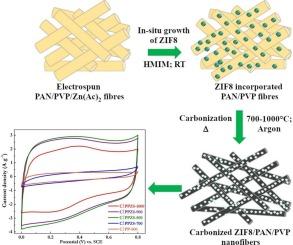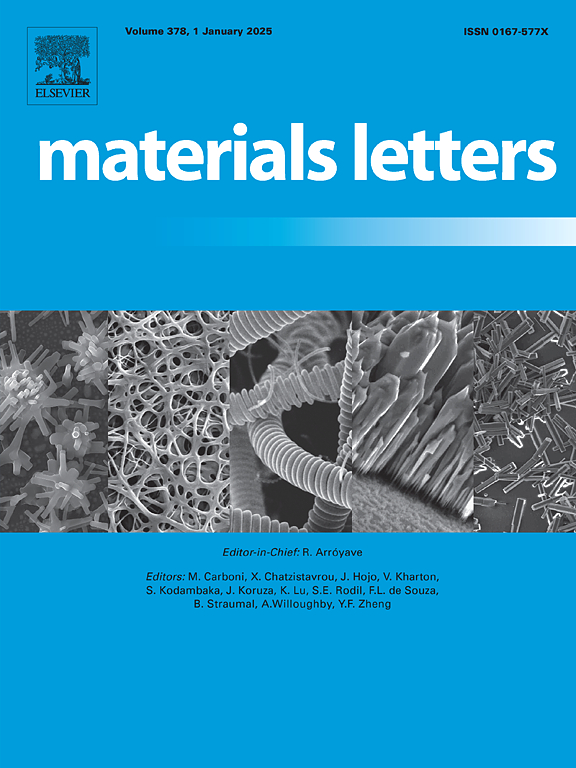应用于超级电容器的碳化沸石咪唑酸盐框架内嵌电纺聚合物纳米纤维复合材料
IF 2.7
4区 材料科学
Q3 MATERIALS SCIENCE, MULTIDISCIPLINARY
引用次数: 0
摘要
碳纳米纤维正迅速成为高效的储能电极材料。有鉴于此,我们建立了一种简单的原位技术,在电纺聚丙烯腈(PAN)-聚乙烯吡咯烷酮(PVP)纳米纤维上生长唑族咪唑酸框架(ZIF8)颗粒。我们的系统实验表明,在 800-900 °C 下碳化的 PAN/PVP/ZIF8 (PPZ8) 纳米纤维(C|PPZ8-800/900)具有电化学电容性。C|PPZ8-800/900 样品在 1.0 M H2SO4 中显示出最大的比电容值(∼180.69 F-g-1)和优异的电化学稳定性(∼100 %)。在碳化过程中,ZIF8 颗粒的加入诱导了 PPZ8 复合材料的介孔行为,并使纳米纤维保持了结构稳定性。测试的 C|PPZ8 纳米纤维复合材料中的石墨化程度和金属锌的痕迹(有助于降低电荷转移电阻)会显著影响其电化学电容性能。本文章由计算机程序翻译,如有差异,请以英文原文为准。

Carbonized zeolitic imidazolate framework-incorporated electrospun polymeric nanofiber composite for supercapacitor applications
Carbon nanofibers are rapidly emerging as efficient electrode materials for energy storage. Given this, we established a simple in-situ technique to grow zeolitic imidazolate framework (ZIF8) particles on electrospun polyacrylonitrile (PAN)–polyvinylpyrrolidone (PVP) nanofibers. Our systematic experiments indicate that the PAN/PVP/ZIF8 (PPZ8) nanofibers carbonized at 800–900 °C (C|PPZ8-800/900) are electrochemically capacitive. The C|PPZ8-800/900 samples exhibit the maximum specific capacitance values (∼180.69 F·g−1) and excellent electrochemical stability (∼100 %) in 1.0 M H2SO4. Incorporation of ZIF8 particles induces a mesoporous behaviour in the PPZ8 composite during carbonization and allows the nanofibers to retain their structural stability. The degree of graphitization and traces of metallic-Zn (contributing towards lower charge-transfer resistance) in the tested C|PPZ8 nanofiber composites significantly affects their electrochemical capacitive performance.
求助全文
通过发布文献求助,成功后即可免费获取论文全文。
去求助
来源期刊

Materials Letters
工程技术-材料科学:综合
CiteScore
5.60
自引率
3.30%
发文量
1948
审稿时长
50 days
期刊介绍:
Materials Letters has an open access mirror journal Materials Letters: X, sharing the same aims and scope, editorial team, submission system and rigorous peer review.
Materials Letters is dedicated to publishing novel, cutting edge reports of broad interest to the materials community. The journal provides a forum for materials scientists and engineers, physicists, and chemists to rapidly communicate on the most important topics in the field of materials.
Contributions include, but are not limited to, a variety of topics such as:
• Materials - Metals and alloys, amorphous solids, ceramics, composites, polymers, semiconductors
• Applications - Structural, opto-electronic, magnetic, medical, MEMS, sensors, smart
• Characterization - Analytical, microscopy, scanning probes, nanoscopic, optical, electrical, magnetic, acoustic, spectroscopic, diffraction
• Novel Materials - Micro and nanostructures (nanowires, nanotubes, nanoparticles), nanocomposites, thin films, superlattices, quantum dots.
• Processing - Crystal growth, thin film processing, sol-gel processing, mechanical processing, assembly, nanocrystalline processing.
• Properties - Mechanical, magnetic, optical, electrical, ferroelectric, thermal, interfacial, transport, thermodynamic
• Synthesis - Quenching, solid state, solidification, solution synthesis, vapor deposition, high pressure, explosive
 求助内容:
求助内容: 应助结果提醒方式:
应助结果提醒方式:


